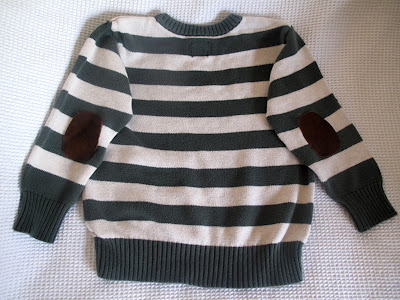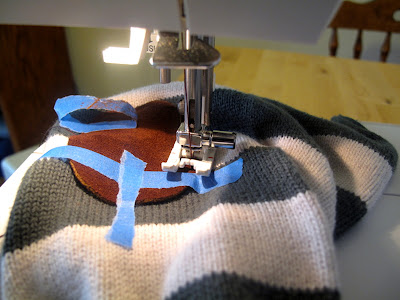My son is three, and he is hard on clothes. Usually things are stained and ripped by the time he grows out of them. This time, his sweater got a hole in the elbow, but it was still in great shape in all other ways. My baby has the cutest striped green and blue sweater with elbow patches, and I thought it would be cute to patch this sweater so that they matched. As a side note, I am a shameless coordinator of my kid's (and sometimes the adult's) clothing, and I plan to keep doing it as long as possible. Who could possibly resist a little boy in a striped sweater with suede elbow patches? What about two little boys? It would be impossible - I love the mini-professor look!
This is such a fast project, and it would be great even with a perfectly whole sweater. From start to finish, I spent about 30 minutes doing these two patches, and I love the result. This is my favourite kind of project - fast, easy, and it looks great.
As you already know, I have a ton of leather sitting around for projects like these, so I dove right in. Don't be intimidated by leather, it's really not as hard to work with as you may think. If you need ideas about where to find leather and tips on sewing with it, read more about it here. Or if you aren't ready to make the plunge, try using another fabric. Corduroy would look dashing as well, but keep in mind that you will need to finish the edges to keep your patches from fraying. In addition, you may need to bulk up woven fabrics a little bit with some fusible interfacing.
Suede Elbow Patches Tutorial
Here is what you'll need for this project:
sweater (with or without holey elbows)
thread to match sweater and leather (heavy duty works best when sewing leather, but general purpose is fine)
sewing machine
leather sewing machine needle
regular sewing machine
Scraps of leather or suede
card stock (I used a piece of junk mail)
painter's tape
Step 1: Make the Patches
You need to make a paper template of your patch before you cut into your leather. Start bigger than you think it should be, and trim it down a little at a time until you have the right size and shape. When you are happy with how your paper patch looks on your sweater, grab your leather and trace two patches on the wrong (back side) of your leather. I always use a ballpoint pen when I'm drawing on leather because it writes well. Obviously, just be careful because you won't be able to easily erase it.
Cut out both patches. I have an older pair of fabric scissors I use for leather. I don't use my best shears, because leather is easy to cut with less sharp scissors and it leaves lots of leather dust on the blades. If you only have one pair, just use them and plan to wipe them off with a clean cloth when you are finished cutting.
Step 2: Get Ready to Sew
Take your leather patches and position them on the elbows of your sweater. You want to make sure that the patch actually ends up on the elbow, so it might be a good idea to have your kid try the sweater on for you. Mark where you want the bottom of the patch to be with a water soluble fabric pen (or painter's tape).
When you are happy with the position of the patches, tape them in place with painter's tape. I always keep a roll of blue painter's tape around because it is useful for all kinds of things, including sewing. Remember how I used it to mark lines on the changing mat tutorial? Or to cover the bottom of a presser foot in lieu of a teflon foot? Here we are going to use the tape to hold the patches in place while we sew. Since pining leather will leave holes, tape makes a good replacement. The other advantage of using tape over pins (in the event that you don't care about holes) is that it's really hard to get a pin through most pieces of leather. Tape is easy to put on, and since we are using painter's tape, it comes right off, without leaving any residue.
Now that your patches are taped in place, you need to open up the arm seam so that you can actually sew the patches on. If you are working with a knit sweater, be careful not to cut holes in the fabric. Rip open the seam all the way to the top of the patch, so you can easily rotate while you sew around those curves.
Step 3: Sew on the Patches
Now you are ready to sew down those patches. Load your sewing machine with thread to match your patch, and put in a leather needle. I like to use heavier weight thread when I sew with leather, but it still works to use regular thread. I've also used a regular needle and it's fine as well, although I think using a leather needle is easier. If this is your only leather project, don't sweat it. A regular needle with regular thread will work.
I like to increase my stitch length (to about 3.5) and use a teflon foot. If you are using suede, like me, you might not have any problems. If you don't have a non-stick foot, and you find your foot is sticking, cover the bottom with painter's tape. Carefully sew around each patch close to the edge, pulling up your tape as you go. Be sure to backstitch when you start and stop each time.
If you opted to use fabric like corduroy instead of leather, I would suggest using a zig-zag stitch all around the edges. You will want one side of the stitch to go off the edge of your patch to keep it from fraying.
Step 4: Sew the Sleeve Seam
Now that your patches are on, flip the sweater inside out and get ready to sew the sleeves back together again.
At this point you may want to change your thread colour and switch out your needle for something more appropriate for sewing your sweater.
Sew, using a straight stitch, close to the edge. Make sure you sew over top of the old seam a little bit to keep it from opening up. If you happened to make a small hole in your knit while opening up the seam, finish the edge by doing a zig-zag stitch that runs over the edge.
Step 5: You're Done
Turn it right side out again, and admire your work. And in my case, go back to the sewing machine to fix the gap in the side seam that you somehow missed. Trim any threads.
Hurray! You are finished. You successfully patched a sweater, and made it look more hip in the process. Now your task is to get your child to hold still long enough to have his picture taken.
Good luck with this last step. I never seem to manage this since my three year old never holds still. He is like a perpetual motion science experiment or something. But I have to admit he looks pretty dashing with his new suede elbow patches.
P.S. Please don't use the pictures with my son's face. Thank you!











4 comments:
yes
very informative digitizing services
Une Ligne Paris has been able to create a unique positioning in the world of costume jewelry over the last four decades Une Ligne
Une Ligne Paris has established a unique presence in the world of fashion jewelry, inspired by global trends and embodying the indescribable beauty click here
Post a Comment